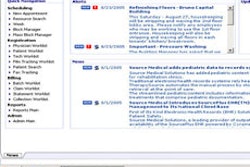A sales representative at a firm I once worked for had received a sizeable purchase order from a new customer for an Internet-based product. There was only one problem with the order: the customer had no information technology network, and thus, no means of utilizing the fundamental capabilities of the product.
Facilities that implement a computerized physician order entry (CPOE) system without integrating it with other clinical application systems shortchange the product's potential, and also create a point where errors can be introduced, according to a presentation at the 2005 RSNA meeting in Chicago.
"Inaccurate delivery of imaging reports to ordering physicians creates delays, and raises concerns related to medical liability and patient safety," said Dr. Michael Matheny from the radiology department at Brigham and Women's Hospital in Boston. "In many centers, computerized radiology ordering data is manually entered into the RIS because of lack of electronic integration between systems."
Matheny's group conducted a study to estimate how frequently a requesting physician is incorrectly identified in a RIS due to manual data entry errors. The team looked at the CPOE system and RIS discordances at Brigham and Women's Hospital, a 720-bed teaching institution that performs more than 400,000 radiology exams on an annual basis.
The researchers compared ordering physician identities for all outpatient radiology exam requests in May 2004 between CPOE (Percipio, Medicalis, Kitchener, Ontario) and RIS (IDXrad version 9.7, IDX Systems, Burlington, VT) databases. According to Matheny, this was prior to the development of a link between the CPOE system and RIS, when ordering information was manually entered into the RIS by radiology staff from a CPOE-generated paper requisition.
The manual entry of data into a RIS can result in suboptimal communication of test results due to misidentification of the requesting physician, Matheny said. In addition, the legibility of handwritten paper requisitions may result in an even higher error rate when that data is transcribed into a RIS, he stated.
For purposes of their study, the researchers assumed that the CPOE system correctly identified the requesting physician. Errors were defined by the team as mismatches in the ordering physician identity between the systems. They then determined the total number of requesting physician identity mismatches as well as the error rate on a per-modality basis.
The group reported that 90 errors were identified in the 11,108 records reviewed, for an overall error rate of 0.84%.
Matheny noted that although the overall referring physician name entry error rate was less than 1%, it would provide little comfort for the patients whose lives could have been affected by a more serious entry error. In addition, because of the potential for discordance between nonintegrated CPOE and RIS applications, he observed that suboptimal communication of test results likely occurs in a substantial number of patients due to the high volume of tests performed in most healthcare facilities.
The researchers reported that the error rates for ultrasound were 2.37% (23 errors out of 971 ordered exams), 1.49% for mammography (19 of 1,279), 1.07% for bone scans (five of 466), 0.65% for nuclear medicine (three of 461), 0.61% for CT (eight of 1,320), 0.55% for x-ray (27 of 4,893), and a low of 0.29% for MRI (five of 1,718). Every one of these errors could have been avoided by integrating the CPOE application with the RIS, according to Matheny.
"Medical information systems that implement CPOE but fail to integrate with downstream systems such as a RIS potentially marginalize the system," he said.
By Jonathan S. Batchelor
AuntMinnie.com staff writer
December 29, 2005
Related Reading
Computerized physician order entry system linked with increased patient mortality, December 7, 2005
Computers no cure-all for medical errors - study, March 9, 2005
New features expand RIS capabilities, October 8, 2004
RIS and PACS -- together at last, June 11, 2004
SCAR members offer solutions for data deluge, February 24, 2004
Copyright © 2005 AuntMinnie.com



















